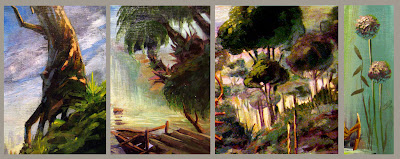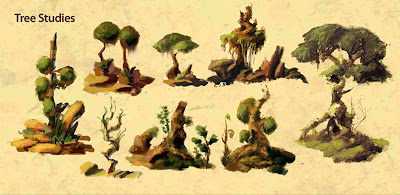
For the next series of paintings, I was on the quest to find originality. What I found was that, originality was elusive. The more I chased after it, the more I was painting the same way, making the same marks that I have always done, painting the same subjects again and again. When I searched for originality and creativity purposefully with intention, I peered over the edge and it seemed that my brain was completely empty.
When I stopped searching, when I decided "not to care," originality came to me. Maybe, originality can only be present if it is unplanned and spontaneous, when parts of your critical attention is turned off. It seemed like such a simple concept so I decided to try it. What I found is that although you cannot force originality, you can do certain things in your everyday life to encourage more moments of spontaneity and clarity. You can create a space and simulate processes that will give you a higher percentage of finding originality.
The formula for originality
Decide not to care. I'm not talking about not caring about your art of your painting, but not caring about how it will turn out, or how it will be received, how you should be painting. If we went to a formal art school, there were certain ways in which we were taught how to paint or approach the canvas. Or even if we were self-taught, there was a pattern which worked for you and you kept doing. I'm telling you to forget the rules.
1. Feed your artist spirit with new experiences - when we are focused on our craft, making a painting, or writing a novel, we are reaching into the countless of brain connections we have made in the past. We reach towards that one color we saw on the cover of national geographic, or the phrasing we've read by our favorite authors, etc. We have these bus routes/train tracks in our brains and if we're limited on how many images we filed away, we'll make the same connections again and again. We'll paint the same kind of tree again and again, because that's the one we know. That's the one that becomes comfortable. But what if you added an 3-inch thick encyclopedia of different types of trees, from the tropics of Indonesia to the Black Forest in Europe? You'll now have built a more interesting array to pull images from. And what if, on top of that, you decided to add an encyclopedia of insects? You now can paint insect-like trees. When feeding your inner artists, make sure to pull from both categories of things that interest you, that you are comfortable with, as well as subjects you know nothing about and what terrifies you.

2. Distract your brain - if our brains are making the same connections again and again. Painting and writing the same things, you need to turn off that part of your brain. Listen to music and paint to the harmony. Write you dialogue script as if it were a baking recipe. Doodle without intention - just let the pen drift in all sorts of direction without reigning them in. Find activities in which you tune out. I get some of my best ideas when I am having tea break, when I'm jogging, or in the shower. Because during those activities, I am not completely focused on art, I am just living.
3. The opposite to the above, pay attention ,very close attention to the minute and mundane - eavesdrop on that boring conversation on the bus, trace the cracks on the sidewalk with your footsteps, notice that speckled texture on your ice cream, or the swirly pattern in your coffee cup. These all can be part of some new alien landscape.
4. Changing your muscle memory - our brains are connected to our hands, even when we doodle, we tend to create the same shapes and patterns without knowing. We've ingrained them to our muscle memory. To change it, or train your muscles to do things differently, you've got to give it a handicap. Doodle with the opposite hand. If you're a right hander, draw with your left. Tie your fingers together so you can only use two. Use a brush the size of your broom. You'll definitely make marks you've never done before.
Now, when you look down at what you've drawn, you'll probably find marks that makes little sense or shapes that look "childish or foreign" because you've never drawn this way before. To make sense of it all. To finally rope in originality, we've got to turn your usual brain back on. We'll need that pattern-finding, sensible, methodical you to make sense of all this randomness. You've got to find the pattern within the chaos.
Originality can't always be summoned by our will. It is often "process-depedent," so in order to find it you'll have to keep reinventing your creative process.



No comments:
Post a Comment